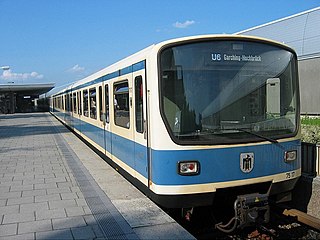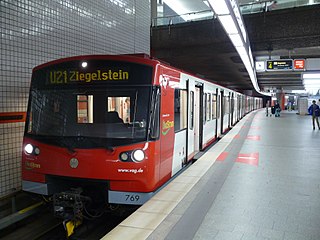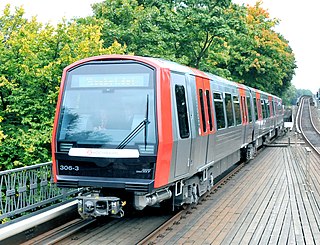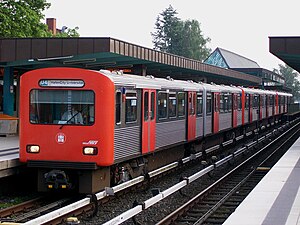
The Siemens Nexas is a class of electric multiple units manufactured by Siemens Transportation Systems for the suburban railway network of Melbourne, Australia between 2002 and 2005. The design of the trains was based on the Siemens Modular Metro.

The Hamburg U-Bahn is a rapid transit system serving the cities of Hamburg, Norderstedt and Ahrensburg in Germany. Although referred to by the term U-Bahn, most of the system's track length is above ground. The network is interconnected with the city's S-Bahn system, which also has underground sections. It is operated by Hamburger Hochbahn within the Hamburger Verkehrsverbund (HVV). It was opened in February 1912, and comprises four lines serving 93 stations, with a route length of 106.4 kilometres (66.1 mi) in 2019.

The Comeng train is a type of electric multiple unit (EMU) that operates on the suburban railway network of Melbourne, Victoria, Australia. Built by Commonwealth Engineering (Comeng) in Dandenong, they were introduced in 1981 as a replacement for the Tait and Harris trains. In total, 570 carriages were built.

The rolling stock on the Berlin U-Bahn are the main types of cars for the underground railway (subway). They are split into two general categories: Kleinprofil and Großprofil lines. The names refer to the size of the train's coaches. Großprofil coaches have a width of 2.65 m and a height of 3.4 m metres, and Kleinprofil coaches are only 2.3 m wide and 3.1 m high. Therefore, the trains have to operate on separate networks.

The Frankfurt U-Bahn is a Stadtbahn system serving Frankfurt, Hesse, Germany. Together with the Rhine-Main S-Bahn and the Frankfurt Straßenbahn, it forms the backbone of the public transport system in Frankfurt. Its name derives from the German term for underground, Untergrundbahn. Since 1996, the U-Bahn has been owned and operated by Stadtwerke Verkehrsgesellschaft Frankfurt am Main (VGF), the public transport company of Frankfurt, and is part of the Rhein-Main-Verkehrsverbund (RMV) transport association. The licence contract is up to 31 December 2031 and is renewable. The contracting authority of VGF is the municipal transport company traffiQ.

The Class 420 is a commuter electric multiple unit train type in service on German S-Bahn networks since 1972. Their use in Munich during the 1972 Summer Olympics earned them the colloquial name Olympiatriebwagen.

The Siemens Modular Metro is a family of electric multiple unit trains for rapid transit systems produced by Siemens Mobility and used by rail operators around the world. The vehicle concept was launched in Vienna in 2000 and is a modular concept allowing many variants of metro vehicles. Previously known as Modular Mobility, Siemens, whose rail equipment division had since been renamed Siemens Mobility, still uses the abbreviation Mo.Mo; however, very little more of these trains are being built, since Siemens had moved to their Inspiro metro platform in 2013.

The Type DT4 is a four-car electric multiple unit (EMU) train type operated by the Hamburger Hochbahn AG on the Hamburg U-Bahn system since 1988.

The Type DT3 is a three-car electric multiple unit (EMU) train type operated by the Hamburger Hochbahn AG on the Hamburg U-Bahn.They were first introduced in 1968 to replace the 1911 to 1929-built Type T cars and to speed up the journey times on line U1.

The Type DT1 is a two-car electric multiple unit (EMU) train type operated by the Hamburger Hochbahn AG on the Hamburg U-Bahn until 1991. They were the first new U-Bahn trains since the 1920s.

The Type A is an electric multiple unit (EMU) train type formerly operated on the Hamburg U-Bahn system. They were the first type of subway cars in Hamburg, entering service on 15 February 1912, and were later designated as Type T. Some cars were converted to maintenance service cars.

The Class G is an electric multiple unit train type used on the Berlin U-Bahn. They were originally developed for the Berliner Verkehrsbetriebe of East-Berlin.

The MVG Class B is an electric multiple unit (EMU) train type operated by the Münchner Verkehrsgesellschaft on the Munich U-Bahn system. The prototypes were delivered in 1981, and the full-production units from 1987. A derivative of the Class B, the VAG Class DT2, is in service on the Nuremberg U-Bahn system.

The MVG Class A is an electric multiple unit (EMU) train type operated by the Münchner Verkehrsgesellschaft on the Munich U-Bahn system. It is the first and oldest type of rolling stock in service on the Munich U-Bahn, and is used on all lines. The prototypes were delivered in 1967, and the full-production units from 1970 until 1983. A derivative of the Class A, the VAG Class DT1, is in service on the Nuremberg U-Bahn system.

The VAG Class DT1 is an electric multiple unit (EMU) train type operated by the Verkehrs-Aktiengesellschaft Nürnberg on the Nuremberg U-Bahn system since its opening in 1972. It is a derivative of the MVG Class A, in service on the Munich U-Bahn since 1971.

The VAG Class DT2 is an electric multiple unit (EMU) train type operated by the Verkehrs-Aktiengesellschaft Nürnberg on the Nuremberg U-Bahn system. It is a derivative of the MVG Class B, in service on the Munich U-Bahn since 1981.

The VAG Class DT3 is an electric multiple unit (EMU) train type operated by the Verkehrs-Aktiengesellschaft Nürnberg on the Nuremberg U-Bahn system. It is the first type of rolling stock on the Nuremberg U-Bahn that has gangways between the individual cars.

The Type DT5 is an electric multiple unit (EMU) train type operated by the Hamburger Hochbahn AG on the Hamburg U-Bahn system. It is the first type of rolling stock on the Hamburg U-Bahn that has air conditioning and gangways between the individual cars.

The VAG Class G1 is an electric multiple unit (EMU) train type operated by the Verkehrs-Aktiengesellschaft Nürnberg on the Nuremberg U-Bahn system. They will replace the VAG Class DT1 and VAG Class DT2 currently in service on Nuremberg U-Bahn line U1. On 20 August 2020, the first of three G1 trains entered into the revenue service.




















